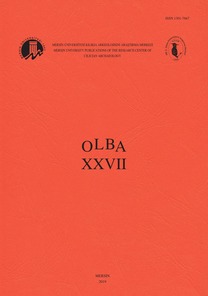AMPHORA MÜHÜRLERİ IŞIĞINDA MILETOS VE
ALEXANDRIA TİCARİ İLİŞKİLERİ
Hellenistik Dönem’de, Ptolemaios’ların yönetiminde Alexandria, şarap ve zeytinyağını da içeren çeşitli gereksinimlerini karşılamak üzere Doğu Akdeniz’in tanınmış üretim merkezleri ile güçlü ticari ilişkiler kurmuştur. Bu bağlantılar,Ptolemaios II, III ve IV’ün yönetimleri sırasında, İ.Ö. c. 261-c. 229 yılları arasına tarihlenen Zenon Papirüsleri gibi antik kaynaklarca da doğrulanmaktadır. Bu kayıtlarda sözü edildiği gibi Miletos, Mısır’a zeytinyağı temin eden merkezlerden biridir. Miletos amphora mühürlerinin tespitine yönelik kentteki son araştırmalar, bizi de amphora mühürleri yardımıyla bu ticaretin somut kanıtını araştırma noktasına getirmiştir. Bu çalışmada Alexandria’da CEAlex (Alexandria Araştırmaları Merkezi) tarafından yapılan kurtarma kazılarında ele geçen ve Alexandria GrekoRomen Müzesi’nde korunan 13 Miletos amphora mühürü sunulmaktadır. Buna ek olarak Miletos kökenli olduğu önerilen, Boethos’un ismini taşıyan 5 amphora mühürü bu makalede yer almaktadır. İki grubun killerinin farklı özelliklere sahip olması, Boethos ismini taşıyan mühürlerin Rhodos Peraiası’nda üretilmiş olduklarını ortaya koymaktadır.
Commercial Relations of Miletus and Alexandria by means
of Amphora Stamps
During the Hellenistic Period, under the reigns of Ptolemies, Alexandria established strong commercial relationships with the known production centers in the Eastern Mediterranean to provide the various demands of the city including wine and olive oil. These connections were also confirmed by the ancient documents as Zenon Papyri dated to c. 261-c. 229 BC, during the reigns of Ptolemy II, III and IV. As mentioned in these documents, Miletos was one of the centers who provided olive oil to Egypt. The latest researches in Miletos on the identification of Milesian amphora stamps brought us to the point of searching the abstract evidence of this trade in Alexandria by means of amphora stamps. 13 Milesian amphora stamps from the rescue excavations of CEAlex (Center for Alexandrian Studies) and held in the Graeco-Roman Museum in Alexandria are presented in this paper. Additionally, 5 stamps naming Boethos which were suggested to be Milesian are given in this article. The different clay characteristics of stamps of both groups indicate that Boethos stamps belong to the amphoras produced in the Rhodian Peraea.
